
|
You entered: Comet Hale-Bopp
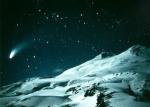 A Hale Bopp Holiday
A Hale Bopp Holiday
25.12.1997
Seen from the Pik Terskol Observatory in the northern Caucasus mountains, comet Hale-Bopp and the bright stars of the constellation Perseus hang above the snowy, moon-lit landscape. Although it reminds Northern Hemisphere dwellers of an idyllic Winter scene, this picture was actually recorded in the spring - on April 13th of this year.
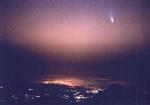 Hale-Bopp Brightest Comet This Century
Hale-Bopp Brightest Comet This Century
25.03.1997
A comet as bright as Comet Hale-Bopp is very rare indeed. No comet has emitted or reflected this much light since possibly the Great Comet of 1811. However, since Comet Hale-Bopp is across the inner Solar System from us, it does not appear as bright as Comet West did in 1975.
 Hale-Bopp and Orion
Hale-Bopp and Orion
29.04.1997
Comet Hale-Bopp is still brighter than most constellations. In fact, Comet Hale-Bopp may now hold the record for staying bright the longest. Last week the comet was photographed above in the same field...
 Hale-Bopp Above the Cinqui Torri Mountains
Hale-Bopp Above the Cinqui Torri Mountains
10.06.1997
Hale-Bopp may be the most photographed comet in history. Above, our photogenic giant flying snowball appeared last month as a backdrop to the "Cinque Torri" Mountains near Contina d'Ampezzo, Italy. Although the comet...
 A Star Cluster Through Hale-Bopp's Tail
A Star Cluster Through Hale-Bopp's Tail
16.04.1997
Comet Hale-Bopp continues to look impressive. The photograph above captured the comet on April 7th passing nearly in front of M34, a star cluster in the constellation of Perseus. Many of the stars in this open cluster can be seen through Comet Hale-Bopp's white dust tail.
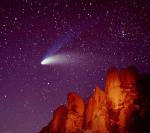 Hale-Bopp from Indian Cove
Hale-Bopp from Indian Cove
6.08.1997
Good cameras were able to obtain impressive photographs of Comet Hale-Bopp when at its brightest earlier this year. In the above photograph taken April 5th, Comet Hale-Bopp was imaged from the Indian Cove Campground in the Joshua Tree National Forest in California, USA.
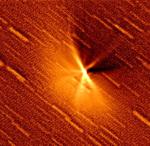 More Jets from Comet Hale-Bopp
More Jets from Comet Hale-Bopp
13.02.1997
Comets become fountains of gas and dust as they get near the Sun. Solar heat vaporizes the outer layers of these spectacular orbiting icebergs, exposing caverns of pressurized gas that erupt into jets. The above digitally enhanced image of Comet Hale-Bopp was taken on January 29th and highlights several of these dust jets.
 Hale-Bopp: Climbing Into Southern Skies
Hale-Bopp: Climbing Into Southern Skies
15.05.1997
Fighting the glow of the setting sun and the city lights of Cape Town, South Africa, comet Hale-Bopp is just visible near the center of this panoramic view - photographed on May 3rd.
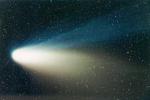 Comet Hale-Bopp's Developing Tail
Comet Hale-Bopp's Developing Tail
14.03.1997
Comet Hale-Bopp is living up to its expectations. Besides the brightness of its coma, a comet is typically remembered by the length of its tails. As visible in the above picture taken last week, Comet Hale-Bopp's blue ion tail shows a dramatic extension, with current reports of about 20 degrees from dark locations.
 Hale Bopp and the North American Nebula
Hale Bopp and the North American Nebula
9.10.1997
Comet Hale-Bopp's recent encounter with the inner Solar System allowed many breath-taking pictures. Above, Comet Hale-Bopp was photographed on March 8th in the constellation of Cygnus. Visible on the right in red is the North American Nebula, a bright emission nebula observable from a dark location with binoculars.
|
January February March April |
|||||||||||||||||||||||||||||||||||||||||||||||||